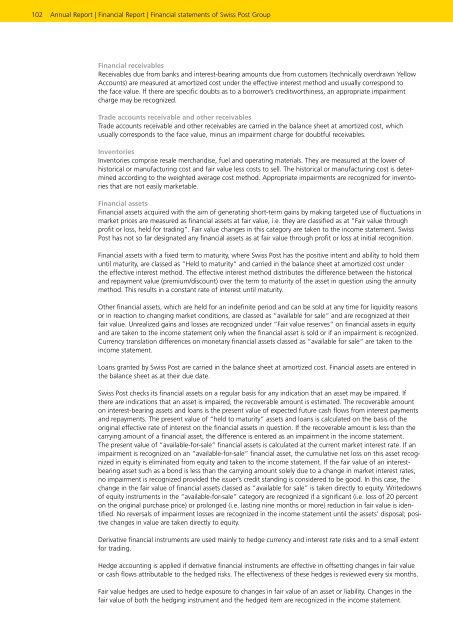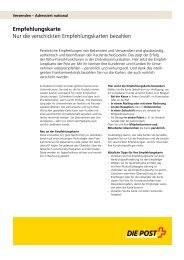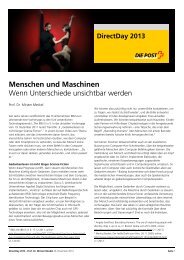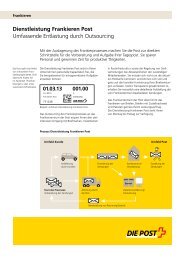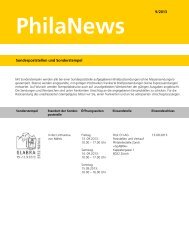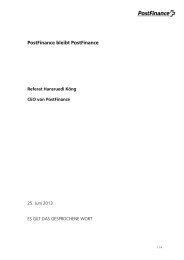Service-oriented - Die Schweizerische Post
Service-oriented - Die Schweizerische Post
Service-oriented - Die Schweizerische Post
You also want an ePaper? Increase the reach of your titles
YUMPU automatically turns print PDFs into web optimized ePapers that Google loves.
102 Annual Report | Financial Report | Financial statements of Swiss <strong>Post</strong> Group<br />
Financial receivables<br />
Receivables due from banks and interestbearing amounts due from customers (technically overdrawn Yellow<br />
Accounts) are measured at amortized cost under the effective interest method and usually correspond to<br />
the face value. If there are specific doubts as to a borrower’s creditworthiness, an appropriate impairment<br />
charge may be recognized.<br />
Trade accounts receivable and other receivables<br />
Trade accounts receivable and other receivables are carried in the balance sheet at amortized cost, which<br />
usually corresponds to the face value, minus an impairment charge for doubtful receivables.<br />
Inventories<br />
Inventories comprise resale merchandise, fuel and operating materials. They are measured at the lower of<br />
historical or manufacturing cost and fair value less costs to sell. The historical or manufacturing cost is determined<br />
according to the weighted average cost method. Appropriate impairments are recognized for inventories<br />
that are not easily marketable.<br />
Financial assets<br />
Financial assets acquired with the aim of generating shortterm gains by making targeted use of fluctuations in<br />
market prices are measured as financial assets at fair value, i.e. they are classified as at “Fair value through<br />
profit or loss, held for trading”. Fair value changes in this category are taken to the income statement. Swiss<br />
<strong>Post</strong> has not so far designated any financial assets as at fair value through profit or loss at initial recognition.<br />
Financial assets with a fixed term to maturity, where Swiss <strong>Post</strong> has the positive intent and ability to hold them<br />
until maturity, are classed as “Held to maturity“ and carried in the balance sheet at amortized cost under<br />
the effective interest method. The effective interest method distributes the difference between the historical<br />
and repayment value (premium/discount) over the term to maturity of the asset in question using the annuity<br />
method. This results in a constant rate of interest until maturity.<br />
Other financial assets, which are held for an indefinite period and can be sold at any time for liquidity reasons<br />
or in reaction to changing market conditions, are classed as “available for sale“ and are recognized at their<br />
fair value. Unrealized gains and losses are recognized under “Fair value reserves“ on financial assets in equity<br />
and are taken to the income statement only when the financial asset is sold or if an impairment is recognized.<br />
Currency translation differences on monetary financial assets classed as “available for sale“ are taken to the<br />
income statement.<br />
Loans granted by Swiss <strong>Post</strong> are carried in the balance sheet at amortized cost. Financial assets are entered in<br />
the balance sheet as at their due date.<br />
Swiss <strong>Post</strong> checks its financial assets on a regular basis for any indication that an asset may be impaired. If<br />
there are indications that an asset is impaired, the recoverable amount is estimated. The recoverable amount<br />
on interestbearing assets and loans is the present value of expected future cash flows from interest payments<br />
and repayments. The present value of “held to maturity” assets and loans is calculated on the basis of the<br />
original effective rate of interest on the financial assets in question. If the recoverable amount is less than the<br />
carrying amount of a financial asset, the difference is entered as an impairment in the income statement.<br />
The present value of “availableforsale” financial assets is calculated at the current market interest rate. If an<br />
impairment is recognized on an “availableforsale” financial asset, the cumulative net loss on this asset recognized<br />
in equity is eliminated from equity and taken to the income statement. If the fair value of an interestbearing<br />
asset such as a bond is less than the carrying amount solely due to a change in market interest rates,<br />
no impairment is recognized provided the issuer’s credit standing is considered to be good. In this case, the<br />
change in the fair value of financial assets classed as “available for sale” is taken directly to equity. Writedowns<br />
of equity instruments in the “availableforsale” category are recognized if a significant (i.e. loss of 20 percent<br />
on the original purchase price) or prolonged (i.e. lasting nine months or more) reduction in fair value is identified.<br />
No reversals of impairment losses are recognized in the income statement until the assets’ disposal; positive<br />
changes in value are taken directly to equity.<br />
Derivative financial instruments are used mainly to hedge currency and interest rate risks and to a small extent<br />
for trading.<br />
Hedge accounting is applied if derivative financial instruments are effective in offsetting changes in fair value<br />
or cash flows attributable to the hedged risks. The effectiveness of these hedges is reviewed every six months.<br />
Fair value hedges are used to hedge exposure to changes in fair value of an asset or liability. Changes in the<br />
fair value of both the hedging instrument and the hedged item are recognized in the income statement.


